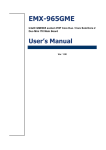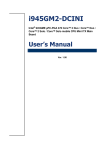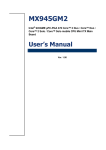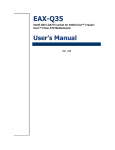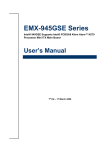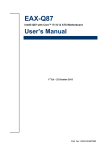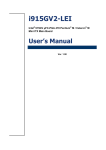Download VIA Technologies VCN700-LIC15 User`s manual
Transcript
VCN700-LIC10/15 VIA CN700 Mini-ITX Motherboard User’s Manual Ver. 1.00 VCN700-LIC10/15 Contents Safety Information ..........................................................................................................4 Technical Support ............................................................................................................5 Conventions Used in This Guide ....................................................................................5 Packing List .......................................................................................................................5 Revision History ...............................................................................................................6 Specifications Summary..................................................................................................7 Specifications Summary..................................................................................................8 Block Diagram...................................................................................................................9 Production Introduction ...............................................................................................11 1.1 Before you Proceed ................................................................................................11 1.2 Motherboard Overview............................................................................................11 1.2.1 Placement Direction ....................................................................................................................... 11 1.3 Motherboard Layout ................................................................................................12 1.4 System Memory ......................................................................................................13 1.4.1 DIMM Sockets Location ................................................................................................................. 13 1.4.2 Installing a DDR2 DIMM................................................................................................................. 14 1.4.3 Removing a DDR2 DIMM............................................................................................................... 14 1.5 1.5.1 Installing an Expansion Card ......................................................................................................... 15 1.5.2 Configuring an Expansion Card ..................................................................................................... 15 1.5.3 PCI Slot .......................................................................................................................................... 15 1.6 Jumpers ..................................................................................................................16 1.6.1 Clear CMOS (CLRTC).................................................................................................................... 16 1.6.2 COM1 RI/+5V/+12V Selection (JCOMPWR1, JCOMPWR2)......................................................... 17 1.7 2 Expansion Slots ......................................................................................................15 Connectors..............................................................................................................18 1.7.1 Rear Panel Connectors .................................................................................................................. 18 1.7.2 ATX Power Connector (ATX12V)................................................................................................... 20 1.7.3 Serial Port 2 Connector (COMB).................................................................................................... 21 1.7.4 CPU Fan Connector (CPU_FAN)................................................................................................... 21 1.7.5 Digital I/O Connector (DIO) ............................................................................................................ 22 1.7.6 Front Panel Audio Connector (F_AUDIO)...................................................................................... 22 1.7.7 System Panel Connector (F_PANEL1) .......................................................................................... 23 1.7.8 USB 2.0 Connector (F_USB1) ....................................................................................................... 24 1.7.9 Primary/Secondary IDE Connector (IDE1, IDE2)........................................................................... 25 User’s Manual Contents 1.7.10 Amplifier Connector (JAMP1) .................................................................................................... 25 1.7.11 LCD Inverter Connector (JBKL1) ............................................................................................... 26 1.7.12 LVDS Connector (JLVDS1) ....................................................................................................... 27 1.7.13 SPI Pin Header Connector (JSPI) ............................................................................................. 27 1.7.14 Serial ATA Connector (SATA1, SATA2) .................................................................................... 28 1.7.15 CPU Fan Connector (SYS_FAN)............................................................................................... 29 BIOS Setup ......................................................................................................................31 2.1 BIOS Setup Program ..............................................................................................31 2.1.1 Legend Box .................................................................................................................................... 32 2.1.2 List Box........................................................................................................................................... 32 2.1.3 Sub-menu ....................................................................................................................................... 32 2.2 BIOS Menu Screen .................................................................................................33 2.2.1 Standard CMOS Features.............................................................................................................. 34 2.2.2 Advanced BIOS Features............................................................................................................... 36 2.2.3 Advanced Chipset Features ........................................................................................................... 42 2.2.4 Integrated Peripherals .................................................................................................................... 44 2.2.5 Power Management Setup............................................................................................................. 49 2.2.6 PC Health Status............................................................................................................................ 51 2.2.7 Load Setup Defaults....................................................................................................................... 52 2.2.8 Set Password ................................................................................................................................. 53 2.2.9 Save and Exit Setup....................................................................................................................... 54 2.2.10 Exit Without Saving.................................................................................................................... 55 VCN700-LIC10/15 3 VCN700-LIC10/15 Safety Information Electrical safety To prevent electrical shock hazard, disconnect the power cable from the electrical outlet before relocating the system. When adding or removing devices to or from the system, ensure that the power cables for the devices are unplugged before the signal cables are connected. If possible, disconnect all power cables from the existing system before you add a device. Before connecting or removing signal cables from the motherboard, ensure that all power cables are unplugged. Seek professional assistance before using an adapter or extension cord. These devices could interrupt the grounding circuit. Make sure that your power supply is set to the correct voltage in your area. If you are not sure about the voltage of the electrical outlet you are using, contact your local power company. If the power supply is broken, do not try to fix it by yourself. Contact a qualified service technician or your retailer. Operation safety Before installing the motherboard and adding devices on it, carefully read all the manuals that came with the package. Before using the product, make sure all cables are correctly connected and the power cables are not damaged. If you detect any damage, contact your dealer immediately. To avoid short circuits, keep paper clips, screws, and staples away from connectors, slots, sockets and circuitry. Avoid dust, humidity, and temperature extremes. Do not place the product in any area where it may become wet. Place the product on a stable surface. If you encounter technical problems with the product, contact a qualified service technician or your retailer. The symbol of the crossed out wheeled bin indicates that the product (electrical and electronic equipment) should not be placed in municipal waste. Check local regulations for disposal of electronic products. 4 User’s Manual Technical Support If a problem arises with your system and no solution can be obtained from the user’s manual, please contact your place of purchase or local distributor. Alternatively, please try the following help resources for further guidance. Visit the Advansus website for FAQ, technical guide, BIOS updates, driver updates, and other information: http://www.advansus.com.tw/Support/Support.asp Conventions Used in This Guide To make sure that you perform certain tasks properly, take note of the following symbols used throughout this manual. DANGER/WARNING: Information to prevent injury to yourself when trying to complete a task. CAUTION: Information to prevent damage to the components when trying to complete a task. IMPORTANT: Instructions that you MUST follow to complete a task. NOTE: Tips and additional information to help you complete a task. Packing List Before you begin installing your single board, please make sure that the following materials have been shipped: 1 x VIA CN700 Mini-ITX Main board 1 x CD-ROM contains the followings: - User’s manual (this manual in PDF file) - Drivers 1 x Startup Manual If any of the above items is damaged or missing, please contact your retailer. VCN700-LIC10/15 5 VCN700-LIC10/15 Revision History Revision V 1.00 6 Revision History First release for PCB 1.00 Date December 03, 2008 User’s Manual Specifications Summary CPU Features On board VIA C7 1.0/1.5 GHz Chipset VIA CN700 Memory One 240-pin DIMM up to total 1GB DDR2 400/533 SDRAM Display 1 x VGA, 1 x LVDS 24 bit Audio LAN Expansion I/O Others Realtek® ALC655, 5.1 Channel Audio Dual Realtek RTL 8110SC Gigabit LAN 1 x PCI 2 x IDE, 2 x SATAII, 6 x USB 2.0, 2 x COM 4 bit DIO (4-in or 4-out), 6W Amp System CPU VIA C7 1.0/1.5 GHz onboard FSB 400 MHz BIOS Award 4 Mb Flash ROM BIOS System Chipset VIA CN700/M I/O Chipset ITE 8712F Memory One 240-pin DIMM up to total 1GB DDR2 400/533 SDRAM H/W Status Monitor Monitoring CPU temperature, voltage, and cooling fan status. Auto throttling control when CPU overheats Expansion Slots 1 x PCI (PCI Rev. 2.3 compliant) DIO 4-bit (4-in or 4-out) Wake up on LAN or Ring Both (PME / RPL / WOR) Display Chipset Display Memory Integrated VIA UniChrome Pro AGP graphics with MPEG-2 Decoding Acceleration VIA S3 UniChrome Pro II 3D Graphic Engine Shared system memory up to 128MB I/O Max. Resolution 1920 x 1440 @75Hz Dual Display Yes(CRT+LVDS) VGA Yes LVDS Yes ,Dual-channel 24-bit LVDS LVDS Backlight Power Yes VCN700-LIC10/15 7 VCN700-LIC10/15 Specifications Summary Audio Audio Codec Realtek® ALC655, 5.1 Channel Audio Audio Interface Mic in, Line in, Line out Audio Amplifier (W) Dual 6W Amp.(TPA3005D2 ) Ethernet LAN1 Realtek RTL 8110SC Gigabit LAN Back I/O Port 1 x PS2 mouse port 1 x PS2 keyboard port 1 x VGA port Back Panel 1 x LPT port 1 x RS-232 COM port 1 x LAN port 4 x USB 2.0 ports 3 x Audio jacks: line-out, line-in, mic-in Internal I/O Connector 1 x RS-232 COM connector 2 x SATA connectors 2 x IDE port connectors 1 x USB 2.0 header for 2 USB ports 1 x DIO connector (4 IN or 4 OUT) Internal I/O 1 x Amplifier connector 1 x Front panel header 1 x 20 pin ATX power connector 1 x Front panel audio connector 1 x CPU fan connector 1 x System fan connector Mechanical & Environmental Power Type ATX mode Size (L x W) 170mm x 170mm * Specifications are subject to change without notice. 8 User’s Manual Block Diagram VCN700-LIC10/15 9 VCN700-LIC10/15 This chapter describes the main board features and the new technologies it supports. 1 Product introduction 10 User’s Manual Production Introduction 1.1 Before you Proceed Take note of the following precautions before you install motherboard components or change any motherboard settings. Unplug the power cord from the wall socket before touching any component. Use a grounded wrist strap or touch a safely grounded object or a metal object, such as the power supply case, before handling components to avoid damaging them due to static electricity Hold components by the edges to avoid touching the ICs on them. Whenever you uninstall any component, place it on a grounded antistatic pad or in the bag that came with the component. Before you install or remove any component, ensure that the ATX power supply is switched off or the power cord is detached from the power supply. Failure to do so may cause severe damage to the motherboard, peripherals, and/or components. 1.2 Motherboard Overview Before you install the motherboard, study the configuration of your chassis to ensure that the motherboard fits into it. Refer to the chassis documentation before installing the motherboard. Make sure to unplug the power cord before installing or removing the motherboard. Failure to do so can cause you physical injury and damage motherboard components. 1.2.1 Placement Direction When installing the motherboard, make sure that you place it into the chassis in the correct orientation. The edge with external ports goes to the rear part of the chassis as indicated in the image below. VCN700-LIC10/15 11 VCN700-LIC10/15 1.3 Motherboard Layout 12 User’s Manual 1.4 System Memory 1.4.1 DIMM Sockets Location The motherboard comes with four 240-pin Double Data Rate 2 (DDR2) Dual Inline Memory Modules (DIMM) sockets. A DDR2 module has the same physical dimensions as a DDR DIMM but has a 240-pin footprint compared to the 184-pin DDR DIMM. DDR2 DIMMs are notched differently to prevent installation on a DDR DIMM socket. The following figure illustrates the location of the sockets: VCN700-LIC10/15 13 VCN700-LIC10/15 1.4.2 Installing a DDR2 DIMM Make sure to unplug the power supply before adding or removing DIMMs or other system components. Failure to do so may cause severe damage to both the motherboard and the components. 1. Unlock a DIMM socket by pressing the retaining clips outward 2. 3. Align a DIMM on the socket such that the notch on the DIMM matches the break on the socket. Firmly insert the DIMM into the socket until the retaining clips snap back in place and the DIMM. A DDR2 DIMM is keyed with a notch so that it fits in only one direction. DO NOT force a DIMM into a socket to avoid damaging the DIMM. The DDR2 DIMM sockets do not support DDR DIMMs. DO NOT install DDR DIMMs to the DDR2 DIMM socket. 1.4.3 Removing a DDR2 DIMM 1. Simultaneously press the retaining clips outward to unlock the DIMM. 2. Remove the DIMM from the socket. Support the DIMM lightly with your fingers when pressing the retaining clips. The DIMM might get damaged when it flips out with extra force. 14 User’s Manual 1.5 Expansion Slots In the future, you may need to install expansion cards. The following sub‑sections describe the slots and the expansion cards that they support. Make sure to unplug the power cord before adding or removing expansion cards. Failure to do so may cause you physical injury and damage motherboard components. 1.5.1 Installing an Expansion Card 1. Before installing the expansion card, read the documentation that came with it and make the necessary hardware settings for the card. 2. 3. 4. 5. 6. Remove the system unit cover (if your motherboard is already installed in a chassis). Remove the bracket opposite the slot that you intend to use. Keep the screw for later use. Align the card connector with the slot and press firmly until the card is completely seated on the slot. Secure the card to the chassis with the screw you removed earlier. Replace the system cover. 1.5.2 Configuring an Expansion Card After installing the expansion card, configure it by adjusting the software settings. 1. Turn on the system and change the necessary BIOS settings if any. 2. Assign an IRQ to the card if needed. Refer to the tables on the next page. 3. Install the software drivers for the expansion card. 1.5.3 PCI Slot This motherboard has two PCI slots. The PCI slots support cards such as a LAN card, SCSI card, USB card, and other cards that comply with PCI specifications. The figure shows a LAN card installed on a PCI slot. VCN700-LIC10/15 15 VCN700-LIC10/15 1.6 Jumpers 1.6.1 Clear CMOS (CLRTC) This jumper allows you to clear the Real Time Clock (RTC) RAM in CMOS. You can clear the CMOS memory of date, time, and system setup parameters by erasing the CMOS RTC RAM data. The onboard button cell battery powers the RAM data in CMOS, which include system setup information such as system passwords. To erase the RTC RAM: 1. Turn OFF the computer and unplug the power cord. 2. Remove the onboard battery. 3. Move the jumper cap from pins 1-2 (default) to pins 2-3. Keep the cap on pins 2-3 for about 5~10 seconds, then move the cap back to pins 1-2. Re-install the battery. Plug the power cord and turn ON the computer. Hold down the <Del> key during the boot process and enter BIOS setup to re-enter data. 4. 5. 6. Except when clearing the CMOS, never remove the cap on CLRTC jumper default position. Removing the cap will cause system boot failure! Normal (Default) Clear RTC 16 User’s Manual 1.6.2 COM1 RI/+5V/+12V Selection (JCOMPWR1, JCOMPWR2) JCOMPWR1 JCOMPWR2 +5V +12V Ring * JCOMPWR2 JCOMPWR1 VCN700-LIC10/15 17 VCN700-LIC10/15 1.7 Connectors 1.7.1 No 1 Rear Panel Connectors Label KB_MS Function PS/2 mouse connector 2 LPT Parallel port connector 3 LAN_USB67 LAN (RJ-45) connector Description The standard PS/2 mouse DIN connector is for a PS/2 mouse. This 25-pin parallel port is a standard printer port that supports Enhanced Parallel Port (EPP) and Extended Capabilities Parallel Port (ECP) mode This port allows Gigabit connection to a Local Area Network (LAN) through a network hub. Refer to the table below for the LAN port LED indications. The optional 10/100 Mbps LAN controller allows 10/100 Mbps connection to a Local Area Network (LAN) through a network hub. ACT / LINK LED Status Description Status Description OFF No link OFF 10Mbps connection Orange Linked ORANGE 100Mbps connection Blinking Data activity GREEN 4 AUDIO1 Line-In port (Light Blue). 5 AUDIO1 Line-Out port (Lime) 18 SPEED LED 1Gbps connection This port connects a tape, CD, DVD player, or other audio sources. This port connects a headphone or a speaker. In 4-channel, 6-channel, and 8-channel configuration, the function of this port becomes Front Speaker Out. User’s Manual No 6 Label AUDIO1 Function Microphone port (Pink) Description This port connects a microphone. Refer to the audio configuration table below for the function of the audio ports in 2, 4, 6, or 8-channel configuration. Port Headset 2-channel 4-channel 6-channel 8-channel Line in Line in Line in Line in Lime Line out Front speaker out Front speaker out Front speaker out Pink Mic In Mic In Mic In Mic In Light Blue 7 LAN_USB67 USB 2.0 connector 8 R_USB USB 2.0 connector 9 10 COMA VGA Serial port connector VGA port 11 KB_MS PS/2 KB connector These two 4-pin Universal Serial Bus (USB) ports are available for connecting USB 2.0 devices. These two 4-pin Universal Serial Bus (USB) ports are available for connecting USB 2.0 devices. D-Sub 9-pin, male This 15-pin port is for a VGA monitor or other VGA-compatible devices. This port is for a PS/2 keyboard VCN700-LIC10/15 19 VCN700-LIC10/15 1.7.2 ATX Power Connector (ATX12V) This connector is for an ATX power supply plugs. The power supply plugs are designed to fit these connectors in only one orientation. Find the proper orientation and push down firmly until the connectors completely fit. Important notes on the Motherboard Power Requirements Make sure that your ATX 12V power supply can provide 8A on the +12V lead and at least 1A on the +5-volt standby lead (+5VSB). The minimum recommended wattage is 230W, or 300W for a fully configured system. The system can become unstable and might experience difficulty powering up if the power supply is inadequate. You must install a PSU with a higher power rating if you intend to install additional devices. 20 User’s Manual 1.7.3 Serial Port 2 Connector (COMB) 1.7.4 CPU Fan Connector (CPU_FAN) Do not forget to connect the fan cables to the fan connectors. Insufficient air flow inside the system may damage the motherboard components, and hardware monitoring errors can occur if you fail to plug this connector. These are not jumpers! DO NOT place jumper caps on the fan connectors. VCN700-LIC10/15 21 VCN700-LIC10/15 1.7.5 Digital I/O Connector (DIO) 1.7.6 Front Panel Audio Connector (F_AUDIO) This connector is for a chassis-mounted front panel audio I/O module that supports either HD Audio or legacy AC ‘97 (optional) audio standard. Connect one end of the front panel audio I/O module cable to this connector. For motherboards with the optional HD Audio feature, we recommend that you connect a high-definition front panel audio module to this connector to avail of the motherboard’s high‑definition audio capability. 22 User’s Manual 1.7.7 System Panel Connector (F_PANEL1) This connector supports several chassis-mounted functions. System Power LED (2-pin PWRLED) This 2-pin connector is for the system power LED. Connect the chassis power LED cable to this connector. The system power LED lights up when you turn on the system power, and blinks when the system is in sleep mode. ATX Power Button/Soft-off Button (2-pin PWRSW) This connector is for the system power button. Pressing the power button turns the system on or puts the system in sleep or soft-off mode depending on the BIOS settings. Pressing the power switch for more than four seconds while the system is ON turns the system OFF. Hard Disk Drive Activity LED (2-pin HDLED) This 2-pin connector is for the HDD Activity LED. Connect the HDD Activity LED cable to this connector. The IDE LED lights up or flashes when data is read from or written to the HDD. Reset Button (2-pin RESET) This 2-pin connector is for the chassis-mounted reset button for system reboot without turning off the system power. VCN700-LIC10/15 23 VCN700-LIC10/15 1.7.8 USB 2.0 Connector (F_USB1) This connector is for USB 2.0 ports. Connect the USB/GAME module cable to any of these connectors, and then install the module to a slot opening at the back of the system chassis. These USB connectors comply with USB 2.0 specification that supports up to 480 Mbps connection speed. Never connect a 1394 cable to the USB connectors. Doing so will damage the motherboard! The USB module is purchased separately. 24 User’s Manual 1.7.9 Primary/Secondary IDE Connector (IDE1, IDE2) IDE1 IDE2 1.7.10 Orient the red markings (usually zigzag) on the IDE cable to Pin 1. Amplifier Connector (JAMP1) VCN700-LIC10/15 25 VCN700-LIC10/15 1.7.11 LCD Inverter Connector (JBKL1) Signal Description Signal VR Signal Description For inverter with adjustable Backlight function, it is possible to control the LCD brightness through the VR signal. Vadj=0.75V ~ 4.25V (Recommended: 4.7KΩ, > 1/16W) ENBKL 26 LCD backlight ON/OFF control signal User’s Manual 1.7.12 LVDS Connector (JLVDS1) 1.7.13 SPI Pin Header Connector (JSPI) VCN700-LIC10/15 27 VCN700-LIC10/15 1.7.14 Serial ATA Connector (SATA1, SATA2) These connectors are for the Serial ATA signal cables for Serial ATA hard disk drives. SA1 SA2 SATA1 SATA2 Install the Windows® 2000 Service Pack 4 or the Windows® XP Service Pack1 before using Serial ATA. When using the connectors in Standard IDE mode, connect the primary (boot) hard disk drive to the SATA1 connector. Connect the right-angle side of SATA signal cable to SATA device. Or you may connect the right-angle side of SATA cable to the onboard SATA port to avoid mechanical conflict with huge graphics cards. 28 User’s Manual 1.7.15 CPU Fan Connector (SYS_FAN) VCN700-LIC10/15 29 VCN700-LIC10/15 This chapter tells how to change the system set tings through the BIOS setup menus. Detailed descriptions of the BIOS parameters are also provided. 2 BIOS setup 30 User’s Manual BIOS Setup 2.1 BIOS Setup Program This motherboard supports a programmable firmware chip that you can update using the provided utility. Use the BIOS Setup program when you are installing a motherboard, reconfiguring your system, or prompted to “Run Setup.” This section explains how to configure your system using this utility. Even if you are not prompted to use the Setup program, you can change the configuration of your computer in the future. For example, you can enable the security password feature or change the power management settings. This requires you to reconfigure your system using the BIOS Setup program so that the computer can recognize these changes and record them in the CMOS RAM of the firmware hub. The firmware hub on the motherboard stores the Setup utility. When you start up the computer, the system provides you with the opportunity to run this program. Press <Del> during the Power-On-Self-Test (POST) to enter the Setup utility; otherwise, POST continues with its test routines. If you wish to enter Setup after POST, restart the system by pressing <Ctrl+Alt+Delete>, or by pressing the reset button on the system chassis. You can also restart by turning the system off and then back on. Do this last option only if the first two failed. The Setup program is designed to make it as easy to use as possible. Being a menu-driven program, it lets you scroll through the various sub-menus and make your selections from the available options using the navigation keys. The default BIOS settings for this motherboard apply for most conditions to ensure optimum performance. If the system becomes unstable after changing any BIOS settings, load the default settings to ensure system compatibility and stability. Select the Load Optimized Defaults from the BIOS menu screen. The BIOS setup screens shown in this section are for reference purposes only, and may not exactly match what you see on your screen. Visit the system builder’s website to download the latest BIOS file for this motherboard VCN700-LIC10/15 31 VCN700-LIC10/15 2.1.1 Legend Box The keys in the legend bar allow you to navigate through the various setup menus Key(s) Function Description General help, only for Status Page Setup Menu and Option Page F1 Setup Menu Return to the main menu from a sub-menu or prompts you to quit Esc the setup program. ←, → Move to the item in the left or right hand ↑, ↓ Move to previous or next item Enter Brings up a selection menu for the highlighted field. + or PgUp Moves the cursor to the first field - or PgDn Moves the cursor to the last field (Shift) F2 key Change color from total 16 colors. F2 to select color forward, (Shift) F2 to select color backward F5 Loads the previous values F6, F7 Loads the fail-safe / optimized defaults F10 Saves changes and exits Setup 2.1.2 List Box This box appears only in the opening screen. The box displays an initial list of configurable items in the menu you selected. 2.1.3 Sub-menu Note that a right pointer symbol appears to the left of certain fields. This pointer indicates that you can display a sub-menu from this field. A sub-menu contains additional options for a field parameter. To display a sub-menu, move the highlight to the field and press <Enter>. The sub‑menu appears. Use the legend keys to enter values and move from field to field within a sub-menu as you would within a menu. Use the <Esc> key to return to the main menu. Take some time to familiarize yourself with the legend keys and their corresponding functions. Practice navigating through the various menus and submenus. If you accidentally make unwanted changes to any of the fields, press <F6> to load the fail-safe default values. While moving around through the Setup program, note that explanations appear in the Item Specific Help window located to the right of each menu. This window displays the help text for the currently highlighted field. 32 User’s Manual 2.2 BIOS Menu Screen When you enter the BIOS, the following screen appears. The BIOS menu screen displays the items that allow you to make changes to the system configuration. To access the menu items, press the up/down/right/left arrow key on the keyboard until the desired item is highlighted, then press [Enter] to open the specific menu. VCN700-LIC10/15 33 VCN700-LIC10/15 2.2.1 Standard CMOS Features The Standard CMOS Features screen gives you an overview of the basic system. 2.2.1.1 Date [Day, xx/ xx/ xxxx] The date format is <week>, <month>, <day>, <year>. 2.2.1.2 Time [xx : xx : xx] The time format is <hour><minute><second>, based on the 24-hour clock. 34 User’s Manual 2.2.1.3 IDE Channel 0/1 Master / Slave IDE HDD Auto-Detection [Press Enter] to select this option for automatic device detection. IDE Primary Master [Auto]: Automatically detects IDE devices during POST [None]: Select this when no IDE device is used. The system will skip the auto-detection setup to make system start up faster. [Manual]: User can manually input the correct settings. Access Mode: The options are CHS/LBA/Large/Auto Capacity: Capacity of currently installed hard disk Cylinder: Number of cylinders Head: Number of heads Precomp: Write precomp Landing Zone: Landing zone Sector: Number of sectors 2.2.1.4 Video This category detects the type of adapter used for the primary monitor that must match your video display card and monitor. EGA / VGA: Enhanced Graphics Adapter/Video Graphics Array. For EGA, VGA, SVGA, or PGA monitor adapters. CGA 40: Color Graphics Adapter, power up in 40 column mode. CGA 80: Color Graphics Adapter, power up in 80 column mode. MONO: Monochrome adapter includes high resolution monochrome adapters. 2.2.1.5 Halt On Set the system to halt on errors according to the system functions specified in each option. Configuration options: [All Errors] [No Errors] [All, But Keyboard] VCN700-LIC10/15 35 VCN700-LIC10/15 2.2.2 Advanced BIOS Features The “Advanced BIOS Features” screen appears when choosing the “Advanced BIOS Features” item from the “Initial Setup Screen” menu. It allows the user to configure the motherboard according to his particular requirements. Below are some major items that are provided in the Advanced BIOS Features screen. A quick booting function is provided for your convenience. Simply enable the Quick Booting item to save yourself valuable time. 36 User’s Manual 2.2.2.1 CPU Features This item allows you to setup the CPU thermal management function. Delay Prior to Thermal With the default value of 16 Minutes, the BIOS activates the Thermal Monitor in automatic mode 16 minutes after the system starts booting up The options: [4 Min], [8 Min], [16 Min], [32 Min]. Thermal Management The options: [Thermal Monitor1], [Thermal Monitor 2]. VCN700-LIC10/15 37 VCN700-LIC10/15 2.2.2.2 Hard Disk Boot Priority Set hard disk boot device priority. 2.2.2.3 Virus Warning Enables or disables the virus warning. Item Description Enabled Activates automatically when the system boots up causing a warning message to appear when anything attempts to access the boot sector or hard disk partition table. Disabled No warning message will appear when anything attempts to access the boot sector or hard disk partition table. 2.2.2.4 CPU L1 & L2 Cache Enabling this feature speeds up memory access. Item 38 Description Enabled Enable cache Disabled Disable cache User’s Manual 2.2.2.5 CPU L2 Cache ECC Checking Item Description Enabled Enable cache ECC checking Disabled Disable cache ECC checking 2.2.2.6 Quick Power On Self Test This allows the system to skip certain tests to speed up the boot-up procedure. Item Description Enabled Enable quick POST Disabled Normal POST 2.2.2.7 First / Second / Third Boot Device The BIOS tries to load the OS from the devices in the sequence set here. The options are: Item Description LS120 LS120 Device HDD-0 First Hard Disk Device SCSI SCSI Device CDROM CDROM Device HDD-1 Secondary Hard Disk Device HDD-2 Third Hard Disk Device HDD-3 Fourth Hard Disk Device ZIP100 ZIP-100 Device USB-FDD USB Floppy Device USB-ZIP USB ZIP Device USB-CDROM USB CDROM Device USB-HDD USB Hard Disk Device LAN Network Device Disabled Disabled any boot device 2.2.2.8 Boot Other Device Use this to boot another device. The options are “Enabled” and “Disabled”. VCN700-LIC10/15 39 VCN700-LIC10/15 2.2.2.9 Boot Up NumLock Status Set the boot up Num Lock status. The options are “On” and “Off”. Item Description On Enable NumLock Off Disable NumLock 2.2.2.10 Typematic Rate Setting The typematic rate is the rate key strokes repeat as determined by the keyboard controller. The commands are “Enabled” or “Disabled”. Enabling allows the typematic rate and delay to be selected. 2.2.2.11 Security Option This category determines whether the password is required when the sys- tem boots up or only when entering setup. The options are: Item Description System The system will not boot and access to Setup will be denied if the correct password is not entered at the prompt. Setup The system will boot, but access to Setup will be denied if the correct password is not entered at the prompt. To disable security, select PASSWORD SETTING at Main Menu and then you will be asked to enter password. Do not type anything and just press <Enter>, it will disable security. Once the security is disabled, the system will boot and you can enter Setup freely. 2.2.2.12 MPS Version Control for OS This option is only valid for multiprocessor motherboards as it specifies the version of the Multiprocessor Specification (MPS) that the motherboard will use. The MPS is a specification by which PC manufacturers design and build Intel architecture systems with two or more processors. MPS 1.1 was the original specification. MPS version 1.4 adds extended configuration tables for improved support of multiple PCI bus configurations and greater expandability in the future. In addition, MPS 1.4 introduces support for a secondary PCI bus without requiring a PCI bridge. 40 User’s Manual 2.2.2.13 OS Select for DRAM > 64MB Select the operating system that is running with greater than 64MB of RAM on the system. The choice: Non-OS2, OS2. 2.2.2.14 Delay for HDD (Secs) The default is [0]. 2.2.2.15 Small Logo (EPA) Show This item allows you enabled/disabled the small EPA logo show on screen at the POST step. Item Description Enabled EPA Logo shows is enabled Disabled EPA Logo show is disabled VCN700-LIC10/15 41 VCN700-LIC10/15 2.2.3 Advanced Chipset Features 2.2.3.1 AGP & P2P Bridge Control VGA Share Memory Size The options: Disabled, 16M, 32M, 64M Direct Frame Buffer The options: Disabled, Enabled. Select Display Device The options: CRT, LCD, TV, DVI, HDTV, CRT+LCD, CRT+TV, CRT+DVI, CRT+HDTV Panel Type The options: 640 x 480 18 bit, 800 x 600 18 bit 1024 x 768 18 bit, 1024 x 768 18 bit / 2 1280 x 768 18 bit, 1280 x 1024 18 bit / 2 1400 x 1050 18 bit / 2, 1280 x 800 18 bit 1024 x 768 24 bit, 1024 x 768 24 bit / 2 1280 x 1024 24 bit / 2, 1400 x 1050 24 bit / 2 1600 x 1200 24 bit / s 42 User’s Manual 2.2.3.2 Memory Hole Enabling this feature reserves 15 MB to 16 MB memory address space for ISA expansion cards that specifically require this setting. This makes memory from 15 MB and up unavailable to the system. Expansion cards can only access memory up to 16 MB. The default setting is “Disabled”. 2.2.3.3 System BIOS Cacheable Selecting “Enabled” allows caching of the system BIOS ROM at F0000h- FFFFFh, resulting in better system performance. However, if any pro- gram writes data to this memory area, a system error may occur. The Choices are “Enabled”, and “Disabled”. 2.2.3.4 Video RAM Cacheable The options: Disabled, Enabled 2.2.3.5 Init Display First This item allows you to choose the first display interface to initiate while booting. The choice is “PCI Slot” or “Onboard”. VCN700-LIC10/15 43 VCN700-LIC10/15 2.2.4 Integrated Peripherals Use this menu to specify your settings for integrated peripherals. 44 User’s Manual 2.2.4.1 OnChip IDE Device On-Chip SATA The chipset contains a SATA IDE interface with support for two IDE channels. Select Enabled to activate the primary IDE interface (Channel0). Select Disabled to deactivate this interface. The options: Disabled, Auto, Combined Mode, SATA Only. SATA Mode Choose the interface of SATA controller. The default setting is “IDE” which let SATA like parallel ATA controller. The “RAID” setting let SATA controller to support RAID. The Advanced Host Controller Interface (AHCI) is a hardware mechanism that allows software to communicate with SATA devices, such as hot-plugging and Native Command Queuing (NCQ). IDE DMA Transfer Access Use this field to enable or disable IDE DMA transfer access. On-Chip Primary / Secondary PCI IDE The chipset contains a PCI IDE interface with support for two IDE channels. Select Enabled to active the primary/secondary IDE interface. Select Disabled to deactivate this interface. The options: [Enabled], [Disabled] VCN700-LIC10/15 45 VCN700-LIC10/15 IDE Prefetch Mode The options: Disabled, Enabled. Primary/Secondary Master/Slave PIO/UMDA The channel has both a master and a slave, making four IDE devices possible. Because two IDE devices may have a different Mode timing (0, 1, 2, 3, 4), it is necessary for these to be independent. The default setting “Auto” will allow auto detection to ensure optimal performance. IDE HDD Block Mode If the IDE hard drive supports block mode select Enabled for automatic detection of the optimal number of block read/writes per sector the drive can support. 46 User’s Manual 2.2.4.2 OnChip PCI Device VIA-3058 AC97 Audio This item allows you to Enabled/Disabled Azalia/AC97 chipset. The options: Auto, AC97 Audio only, Disabled. OnChip USB Controller The options: All disabled, All enabled. OnChip EHCI Controller The options: Enabled, Disabled. USB Emulation The options: OFF, KB/MS, ON. VCN700-LIC10/15 47 VCN700-LIC10/15 2.2.4.3 Super I/O Device Onboard Serial Port Select an address and corresponding interrupt for the first and second serial ports. The choice: [Disabled], [3F8/IRQ4], [2F8/IRQ3], [3E8/IRQ4], [2E8/IRQ3], [Auto] Onboard Parallel Port The choice: [Disabled], [378/IRQ7], [278/IRQ5], [3BC/IRQ7] Parallel Port Mode This field allows you to set the operation mode of the parallel port. The choice: [SPP], [EPP], [ECP], [ECP + EPP] 48 User’s Manual 2.2.5 Power Management Setup The power management setup controls the single board computer's “green” features to save power. The following screen shows the manufacturer’s defaults. 2.2.5.1 ACPI Function The choices are “Enabled” and “Disabled”. 2.2.5.2 ACPI Suspend Type This item allows you to set ACPI suspend type to S1/POS(Power On Suspend) or S3/STR(Suspend To RAM). 2.2.5.3 Suspend Mode Item Description Min. Power Saving Minimum power management, HDD Power Down = 15 Min, Max. Power Saving Maximum power management, HDD Power Down =1 Min User Defined Allows you to set each mode individually. When not disabled, each of the ranges are from 1 min. to 1 hr. except for HDD Power Down which ranges from 1 min. to 15 min. and disable. VCN700-LIC10/15 49 VCN700-LIC10/15 2.2.5.4 Run VGABIOS if S3 Resume Select “Auto” to run VGA BIOS if S3 resume automatically. The “Yes” enables running VGA BIOS if S3 resume. The “No” disables this function. 2.2.5.5 Ac Loss Auto Rest The options: Off, On, Former-Sts. 2.2.5.6 PowerOn by PCI Card This will enable the system to power on through PCI/LAN peripheral. The options: Disabled, Enabled. 2.2.5.7 Modem Ring Resume The options: Disabled, Enabled. 2.2.5.8 RTC Alarm Resume The options: Disabled, Enabled. 50 User’s Manual 2.2.6 PC Health Status 2.2.6.1 System Temperature This shows you the current temperature of system. 2.2.6.2 CPU Temperature This shows the current CPU temperature. 2.2.6.3 CPU FAN Speed This shows the CPU FAN Speed.(RPM) 2.2.6.4 VCore and Others Voltage This shows the voltage of VCORE, +5V, +12V, VCC(V), AVCC(V), VCC3(V), VBAT(V), and 3VSB(V). VCN700-LIC10/15 51 VCN700-LIC10/15 2.2.7 Load Setup Defaults Use this menu to load the BIOS default values that are factory settings for optimal performance system operations. While Award has designed the custom BIOS to maximize performance, the factory has the right to change these defaults to meet their needs. Press <Y> to load the default values setting for optimal performance system operations. 52 User’s Manual 2.2.8 Set Password You can set password. It is able to enter/change the options of setup menus. Follow these steps to change the password. Choose the “Set Password” option from the “Initial Setup Screen” menu and press <Enter>. The screen displays the following message: Please Enter Your Password Press <Enter>. If the CMOS is good and this option has been used to change the default password, the user is asked for the password stored in the CMOS. The screen displays the following message: Please Confirm Your Password Type the current password and press <Enter>. After pressing <Enter> (ROM password) or the current password (user-defined), you can change the password stored in the CMOS. The password must be no longer than eight (8) characters. Remember, to enable the password setting feature, you must first select either “Setup” or “System” from the “Advanced BIOS Features” menu. VCN700-LIC10/15 53 VCN700-LIC10/15 2.2.9 Save and Exit Setup If you select this and press <Enter>, the values entered in the setup utilities will be recorded in the CMOS memory of the chipset. The processor will check this every time you turn your system on and compare this to what it finds as it checks the system. This record is required for the sys- tem to operate. 54 User’s Manual 2.2.10 Exit Without Saving Selecting this option and pressing <Enter> lets you exit the setup program without recording any new values or changing old ones. VCN700-LIC10/15 55
























































